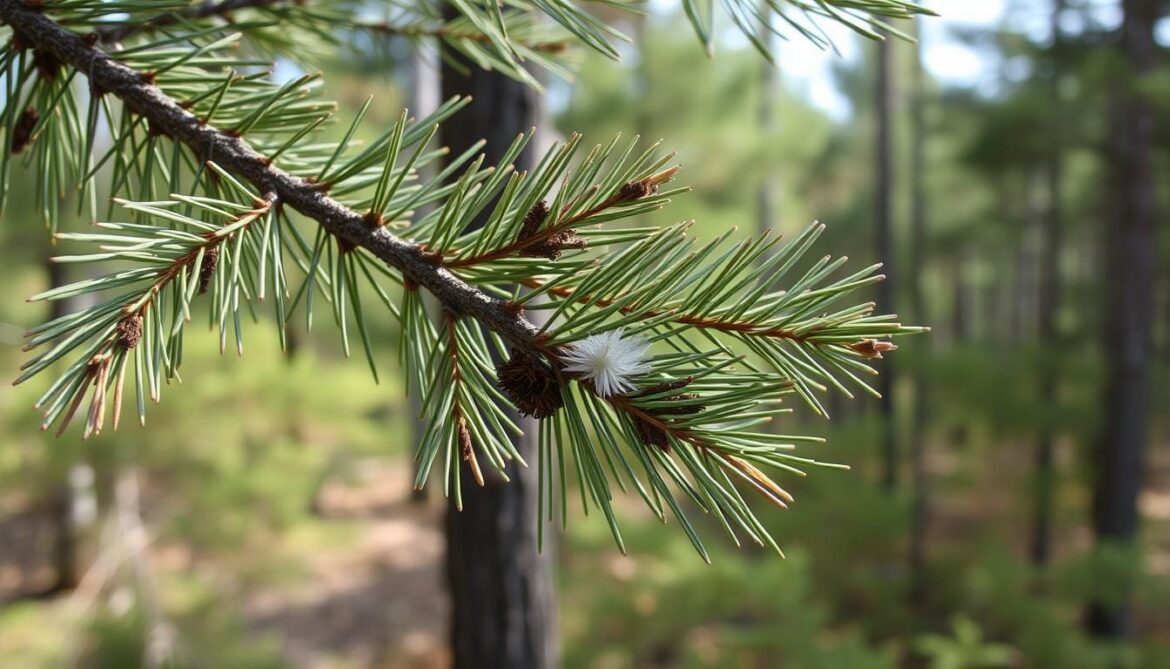I’ve always loved the outdoors and the beauty of white pines. These trees have been around for centuries, offering shade and peace. But lately, I’ve seen them decline due to white pine needle disease.
Seeing healthy pines turn sick is heartbreaking. Their symptoms, like discolored needles and early shedding, show the problem. I want to help find a way to save these trees.
In this guide, we’ll look at ways to fight white pine needle disease. We’ll cover fungicides, natural remedies, and more. Our goal is to protect our white pines for the future.
Key Takeaways
- White pine needle disease is a serious issue affecting the health and longevity of white pines
- Early detection and proper treatment are crucial for managing this disease
- A range of treatment options, from fungicides to cultural practices, can be employed to address white pine needle disease
- Maintaining soil health and understanding environmental factors are key to preventing and managing the disease
- Collaboration with professionals and community involvement are essential for effective white pine disease management
Understanding White Pine Needle Disease
White pine needle disease (WPND) is a serious fungal infection that affects many pine species, including the Eastern white pine. It’s becoming more common in the northeastern United States. Homeowners, foresters, and land managers face a big challenge in managing WPND. Knowing its nature, symptoms, and causes is key to fighting it.
What Is White Pine Needle Disease?
WPND is caused by several fungi, mainly Lecanosticta acicola and Mycosphaerella dearnessii. These fungi harm the needles of white pine trees. This can weaken the trees’ health and vitality.
Symptoms to Look For
The first signs of WPND are circular, gray-green spots on pine needles. These spots grow and turn into brown bands. As the disease gets worse, the needles may turn yellow, brown, and fall off early.
Causes of White Pine Needle Disease
WPND loves wet weather, spreading through rain and contaminated tools. Wind can also spread the spores. Knowing the exact fungus is important for the right treatment, which might include copper-based fungicides.
Understanding WPND helps us manage it better. We can protect our pine trees and keep our landscapes healthy and strong.
The Importance of Early Detection
Spotting white pine needle disease early is key to saving our pine trees. We can catch it by regularly checking our trees. Look for yellow-to-brown spots, early needle drop, and bare lower branches.
These signs are more common in warm, wet summers. Catching them early can stop the disease from getting worse.
How Early Detection Helps Us
Finding the disease early lets us act fast. This helps avoid serious damage or even tree death. It’s especially important for young trees that might get sick every year.
Early detection means we can start preventative measures and get expert advice. This keeps our pine trees healthy for a long time.
Common Signs We Should Monitor
- Yellow-to-brown spots on needles, indicating disease symptoms
- Premature needle shedding, a sign of needle discoloration
- Bare lower branches, potentially a result of preventative measures
By watching for these signs and acting quickly, we can control white pine needle disease. This helps keep our pine trees healthy and beautiful for many years.
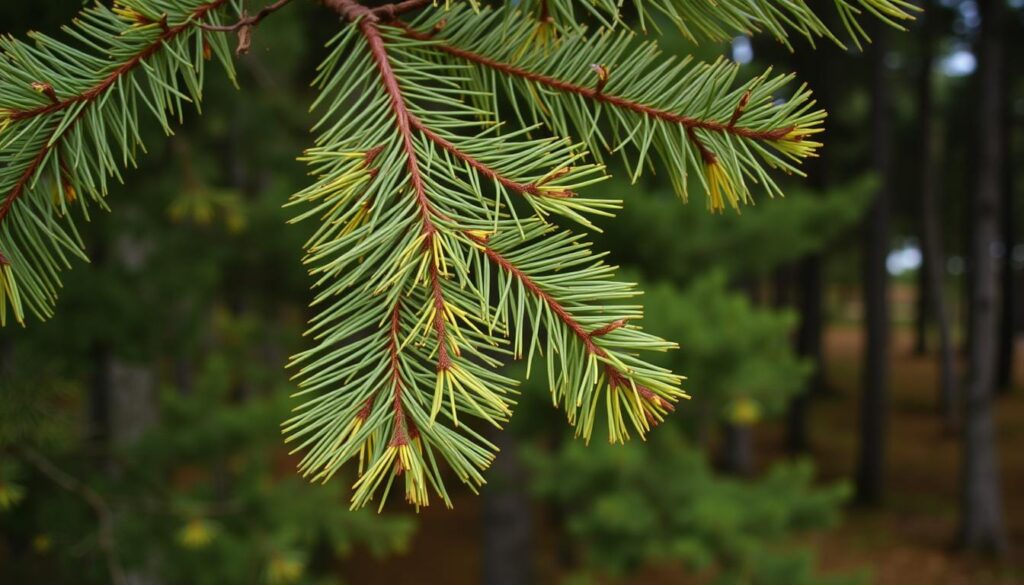
“Early detection of white pine needle disease is the key to successful treatment and long-term tree health.”
Treatment Options Available
There are many ways to fight white pine needle disease. Land managers and homeowners can use chemical and natural treatments. They can also mix different methods for the best results.
Chemical Treatments
Copper-based fungicides are a common choice. They include copper sulfate pentahydrate or copper hydroxide. These protect needles early on. Chlorothalonil is another good fungicide for this disease.
Natural Remedies
Natural ways to fight the disease exist too. Pruning and thinning improve air flow and lower moisture. This stops fungi from growing. Deep, less frequent watering and mulching also help the tree stay healthy.
Integrated Pest Management Strategies
IPM strategies use both chemicals and natural methods. This might mean applying fungicides when needles are half-grown. Then, reapply every 3-4 weeks. Prune infected branches in dry weather and sterilize tools to stop disease spread.
Using chemicals, natural methods, and IPM together helps manage white pine needle disease. This keeps pine trees healthy and strong.
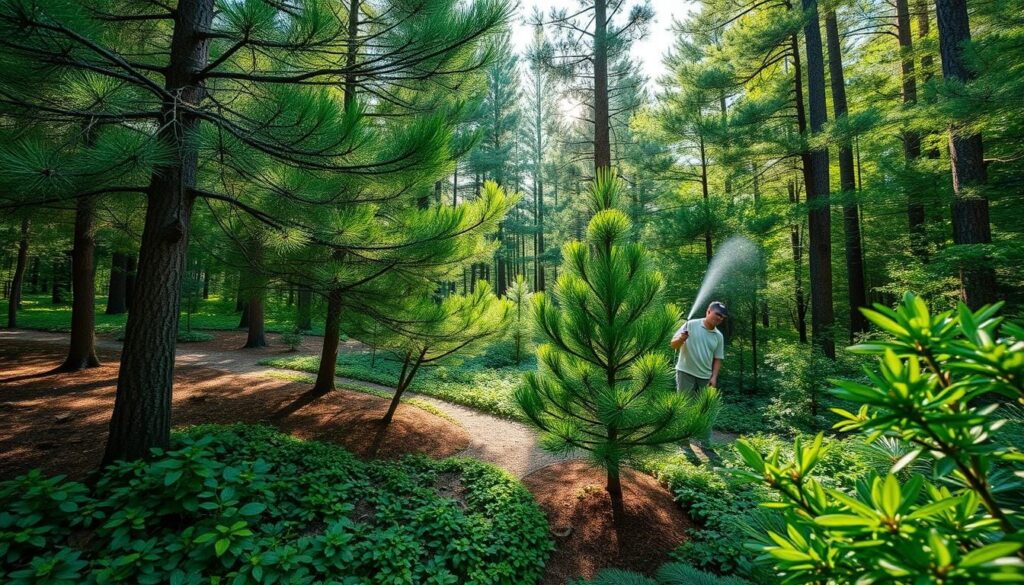
Best Practices for Prevention
To prevent white pine needle disease, we need to take action. This includes using the right maintenance techniques and picking pine trees that are resistant to disease. By doing these things, we can keep our pine trees healthy and fight off this disease.
Proper Maintenance Techniques
Keeping air moving around pine trees is key to stopping white pine needle disease. We can do this by planting trees far enough apart and trimming lower branches. Also, watering at the base of the trees instead of overhead helps prevent disease.
Choosing Resistant Pine Varieties
Choosing pine trees that are resistant to disease is important. Research has found some pine species and varieties that are more resistant to this disease. By planting these trees, we can protect our pine trees better.
Watching for infected needles and removing them quickly is also crucial. Adding a 3-4 inch layer of wood chip mulch around the trees helps too. It keeps weeds away and keeps the soil moist, making it harder for disease to grow.
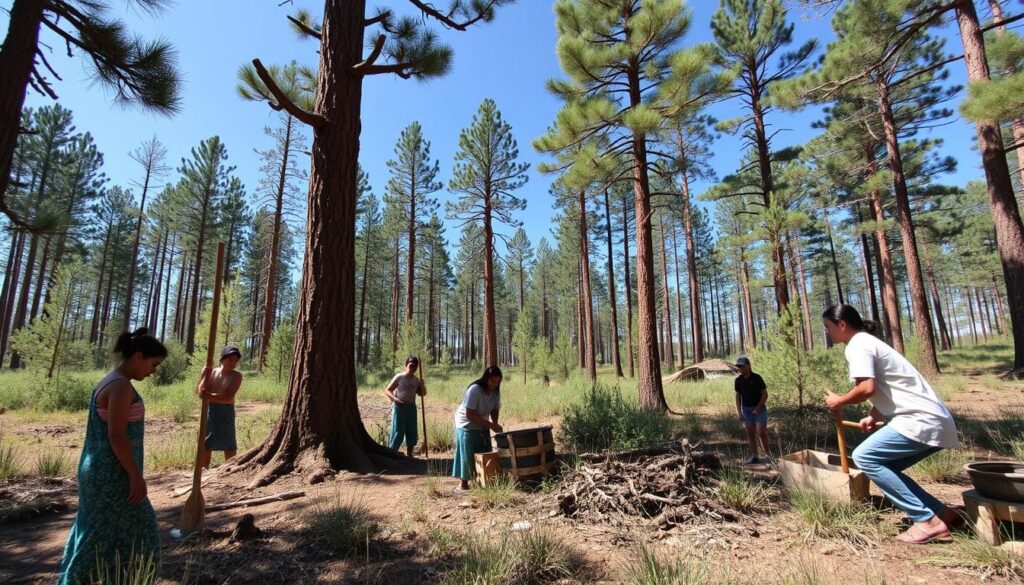
“Proactive management through proper maintenance and strategic planting choices can significantly improve our ability to prevent the devastating effects of white pine needle disease.”
Importance of Soil Health
Soil health is key for white pine trees to fight off white pine needle disease. Regular soil tests help us know the nutrient levels and pH balance. This directly affects the health and disease resistance of pine trees.
Soil Testing and Amendments
Soil tests show what nutrients the soil needs. We can then add the right amendments. Adjusting the pH to 5.5 to 6.5 helps trees absorb nutrients better.
Adding organic matter like compost improves soil structure and water retention. This supports the trees’ growth and health.
How Soil Quality Affects Tree Health
Good soil drains well and is rich in nutrients. It helps white pine trees fight off diseases. Poor soil, nutrient imbalances, or too much water weaken trees.
By keeping soil conditions right, we boost trees’ natural defenses. This makes them more resilient against diseases.
It’s crucial not to over-fertilize. Too many nutrients can harm trees by making them more vulnerable to diseases. A balanced soil ecosystem is vital for strong growth and disease resistance in white pine trees.
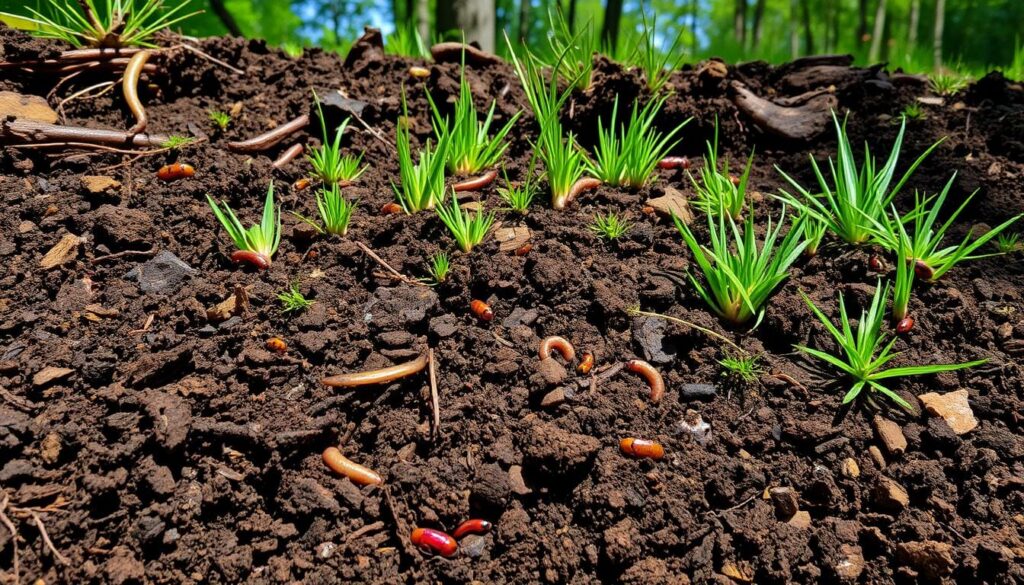
“Healthy soil is the foundation for healthy, disease-resistant trees. By addressing soil nutrient levels and structure, we can empower white pines to thrive and overcome the challenges of white pine needle disease.”
Role of Climate in Disease Severity
The severity of white pine needle disease is heavily influenced by environmental factors, particularly climate. As we grapple with the effects of climate change, understanding how these environmental stressors impact disease progression is crucial for effective management strategies.
Understanding Environmental Stressors
Warm, humid conditions provide an ideal breeding ground for the fungi that cause white pine needle disease. Increased precipitation and prolonged wet periods can promote the growth and dispersal of fungal spores, leading to more widespread infections. Conversely, drought stress can weaken trees, making them more susceptible to disease.
Other environmental factors, such as excessive shade or compacted soils, can also contribute to tree stress and compromise their ability to fend off disease. By closely monitoring these environmental factors, we can better anticipate the disease severity and implement appropriate environmental control measures.
Adapting Management Practices
To mitigate the impact of climate factors on white pine needle disease, it’s essential to adapt our management practices to the local environmental conditions. This may involve adjusting watering schedules during prolonged wet periods, providing additional protection for trees during drought stress, or selectively pruning to improve air circulation and sunlight exposure.
Regular monitoring of weather forecasts can also help us anticipate disease-favorable conditions and implement preventative measures accordingly. By proactively addressing environmental stressors, we can enhance the resilience of our white pine forests and minimize the disease severity caused by changes in the climate.
“Climate change likely expanded the suitable area for blister rust by 777.9 km2 into previously inhospitable regions.”
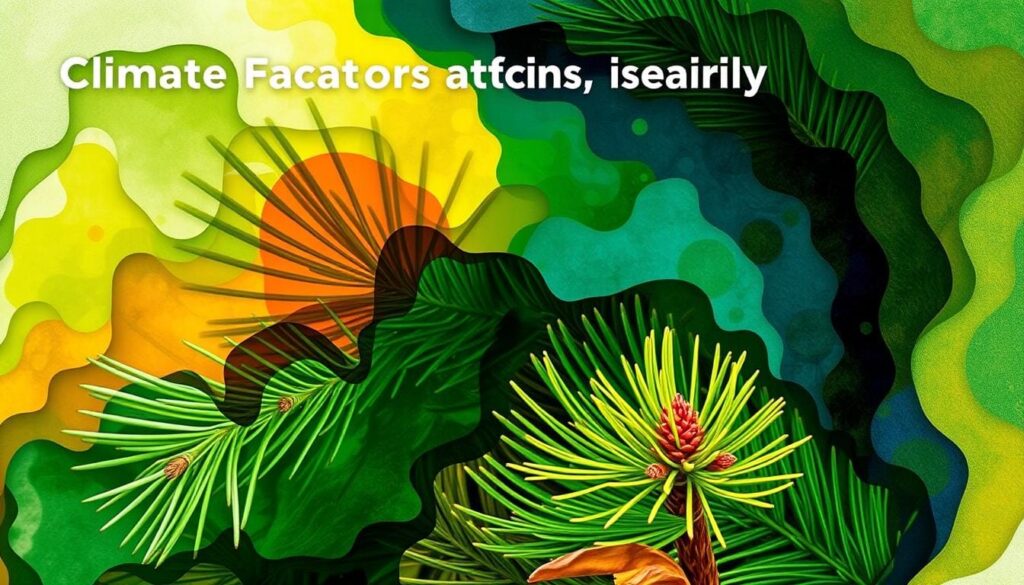
The Impact of White Pine Needle Disease on Ecosystems
White pine needle disease is a big problem that goes beyond just how our forests look. It can harm the balance of our ecosystems, affecting wildlife and biodiversity. It also has big economic costs for forest management, as it can lower timber quality and raise management costs.
Effects on Wildlife and Biodiversity
Severe outbreaks of white pine needle disease can kill trees. This disrupts the homes and food of many wildlife species. The loss of these trees can change the ecosystem dynamics, harming other plants and animals that depend on them.
This can lead to a drop in biodiversity and the health of the forest ecosystem.
Economic Implications for Forest Management
The impact of white pine needle disease on forests is big. It can make timber quality go down and increase management costs. This is a big worry for forest owners and managers, especially in places like the Northeastern United States.
Proper disease management and early action are key to keeping forests healthy. By tackling the ecosystem impact and economic costs of white pine needle disease, we can protect our forests and the life they support for the long term.
“The loss of these pine trees can alter the ecosystem dynamics, affecting other plant and animal communities that rely on them.”
Working with Professionals
Managing white pine needle disease is easier with professional help. Home remedies and DIY treatments might help a bit. But, for serious cases, experts are needed.
When to Consult an Arborist
Notice your white pine trees still have disease signs? Or is the disease getting worse fast? It’s time to call an arborist. They can check your trees, find the problem, and create a plan just for them.
Benefits of Hiring Tree Care Specialists
- Accurate disease diagnosis and targeted treatment recommendations
- Proper application of fungicides and other control measures
- Identification of underlying issues contributing to disease susceptibility
- Ongoing monitoring and management strategies to prevent future outbreaks
- Expertise in preserving the overall health and vitality of your pine trees
Working with professional tree care experts can save your white pines. They help keep your trees healthy against white pine needle disease. Their knowledge is key in disease diagnosis and treatment.
“Consulting an arborist is crucial when dealing with complex tree health issues like white pine needle disease. Their expertise can make all the difference in saving your trees and preventing the spread of the disease to the surrounding landscape.”
DIY Treatments: What We Can Try
There are DIY treatments for white pine needle disease. Home remedies and cultural practices can help. But, it’s important to know their limits and risks before trying them.
Home Remedies and Their Effectiveness
Neem oil, baking soda solutions, and better air circulation are common DIY treatments. They might help with minor infections. But, they might not work well for all cases.
Neem oil can fight the disease if used right. But, it needs to be applied carefully. Baking soda solutions have mixed results. Their long-term effect on trees is not clear.
Risks of DIY Treatments
DIY treatments can be risky if done wrong. Wrong pruning can spread the disease. Using the wrong fungicides can harm the tree and soil.
If the problem is serious or you’re unsure, get help from a certified arborist or local extension office. They can give you safe and effective advice for your area.
Monitoring and Reporting
Keeping an eye on pine health is key to catching white pine needle disease early. We must check our pine trees often, especially in spring and summer. This is when we can see signs of disease.
By watching our pine trees, we can spot disease signs, see how treatments work, and check the health of our pines. This helps us take care of our forest better.
Telling others about big disease outbreaks is just as important as watching for them. If we see a lot of disease, we should tell local experts. They can then help stop the disease from spreading.
Early warnings help everyone work together to fight the disease. This way, we can keep our forests healthy and strong.
Keeping Track of Pine Health
- Set up a regular check-up schedule, especially in spring and summer
- Keep records of any disease signs, treatments, and how well they work
- Keep detailed notes to track how the disease is spreading
Reporting Outbreaks to Authorities
- Tell local experts about big disease outbreaks
- Give them all the details about the outbreak
- Work with them to come up with plans to manage the disease
- Ask neighbors to report any disease signs too
By watching our pine trees closely and telling others about disease, we help fight white pine needle disease. This teamwork keeps our forests healthy and helps our environment stay balanced.
Community Involvement and Education
Stopping white pine needle disease needs everyone’s help. We can fight it by working together. By teaching and sharing, we can all help manage this problem.
How We Can Educate Our Community
We can teach our community through workshops. These will cover what the disease is, why it happens, and how to stop it. We’ll work with local groups and schools to reach more people.
Local Resources for Pine Health Information
Our area has many resources for pine health. Chikus Garden is a great place for gardeners to share and learn. We can also work with local experts to spread the word.
| Local Resource | Expertise | Contact Information |
|---|---|---|
| Cooperative Extension Service | Horticultural advice, disease identification, and management strategies | extension.org |
| Master Gardener Program | Hands-on gardening workshops, plant clinics, and community outreach | mastergardener.extension.org |
| Forestry Department | Forest health monitoring, research, and technical assistance | stateforestry.org |
By using these resources and working together, we can fight white pine needle disease. This will help our pine trees stay healthy for a long time.
“Collaboration and education are key to preserving the beauty and ecological value of our pine forests. Together, we can make a difference.”
Case Studies: Successful Treatments
Looking at successful treatment cases gives us important insights. They show how to manage white pine needle disease well. Our area has seen many success stories. These stories show the power of working together and acting fast to control diseases.
Examples of Effective Treatment in Our Region
In the Great Lakes, a study showed how to fight brown spot needle blight in Scots pines. It used fungicides and better care for the trees. In the northeastern U.S., early spotting and quick treatment with copper fungicides cut down disease in Eastern white pines.
Lessons Learned from Successful Cases
These treatment success stories teach us a lot. They show the importance of regional case studies in making disease management strategies. They tell us to use both chemicals and natural methods. They also stress the need for constant watching and prevention.
“The key to success lies in early detection and a comprehensive management plan that addresses the unique challenges of our regional landscapes.”
As we keep fighting white pine needle disease, these stories are very helpful. They guide us towards better and lasting solutions.
Future Research Directions
We are working hard to fight white pine needle disease. New research and treatments are showing great promise. Our goal is to protect our eastern white pine forests for the future.
Emerging Treatments on the Horizon
Researchers are looking into using natural fungi and bacteria to fight the disease. They also want to breed trees that can resist these diseases better. This could help save our eastern white pine forests.
The Role of Technology in Disease Management
New technology is helping us fight white pine needle disease. Tools like drones and AI can spot diseases early. This means we can treat them faster and better. It’s a big step towards keeping our eastern white pine forests healthy.
